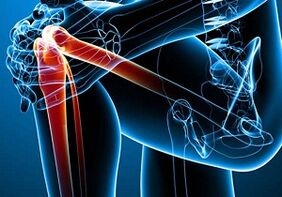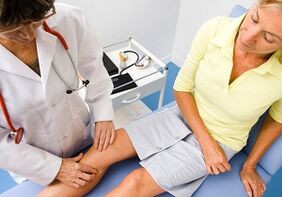People of different ages, especially after 40-50 years, often have joint problems, but without the help of specialists it is difficult to determine which disease is developing. Common diseases are arthritis and arthrosis. What is the difference, how to treat, how to prevent articular pathology?
Expert advice on the treatment of diseases of the musculoskeletal system will be useful to many. It is important to understand how to recognize arthritis and arthrosis for treatment to be successful.
General signs

Articular pathology has a similar root in name. Translated from the Greek "arthron" means "together".
Arthrosis and arthritis are damage to the joints. The pathological process is accompanied by discomfort, pain, damage to cartilage tissue, mobility of problem areas is limited. Both arthritis and arthrosis interfere with the patient’s normal life journey.
When distinguishing a disease, it is important to take into account all the signs, conduct the necessary studies and analysis.
Articular pathology has many differences, misdiagnosis reduces the quality of treatment.
Basic information on joint pathology
It is important to understand not only the similar and distinctive signs of arthrosis and arthritis, but also the causes, types, and characteristics of the course of articular pathology. Understanding the provoking factors, under the influence of negative processes in cartilage tissue begins, will help prevent disease.
| Joint pain | arthrosis | |
|---|---|---|
| The reasons | Inflammation against the background of systemic pathology or infection of articular tissues | Destruction of cartilage during tissue wear, more frequent in old age. Improper metabolism causes loss of elasticity, changes in cartilage structure, abrasion, destruction of part or all of cartilage tissue. |
| Provoking factors | Infectious diseases, allergies, injuries, hypothermia, disorders in metabolic processes, heredity, stress, vitamin deficiency | Body aging, overweight, injury, malnutrition, autoimmune pathology, deterioration of blood supply to cartilage and bone tissue, inflammatory processes in the body, dysfunctional thyroid gland, excessive pressure on the joints, hypothermia, hereditary predisposition |
| Type of pathology | monoarthritis, polyarthritis | Primary (cartilage damage with lack of nutrients, poor blood circulation). Secondary - the disease develops in the affected joint, more often after injury |
| Forms of the disease | Bernanah, rheumatoid, juvenile, gouty | Four stages: from slight narrowing of the joint space to significant deformity with complete closure of the joint space |
| Complications | The prolonged presence of infectious agents in the joints and other organs affects health, reduces immunity. Limb mobility is impaired, during periods of exacerbation, swollen tissues, pain, difficult to perform many normal movements. | In the absence of treatment: complete destruction of joints, immobilization of limbs, negative changes in the intervertebral disc |
| Prediction | With timely treatment, elimination of inflammatory processes, many types of arthritis can be completely cured. | The disease is difficult to treat, in most cases it becomes chronic. Arthrosis is an irreversible process; it is impossible to restore the quality of cartilage tissue by 100%. Competent therapy improves the condition of cartilage, maintains limb function, but if certain rules are violated, the disease develops. |
What is the difference between arthritis and arthrosis
Articular pathology has more differences than similar signs. It is easy to distinguish arthritis from arthrosis with knowledge of the etiology of the disease.
Information for patients:
- arthritis develops against the background of inflammatory processes in the joints, arthrosis is the result of degenerative processes, degenerative changes in cartilage tissue;
- both pathologies have acute and chronic forms, but arthritis occurs with more pronounced symptoms, the inflammation actively spreading not only to the joints, but also to other areas;
- arthrosis is a protracted disease, longer remission, cartilage is gradually destroyed without severe inflammation of the tissues.
The table describes the differences in articular pathology according to the main features:
| Joint pain | arthrosis | |
|---|---|---|
| Causes of pathological changes | Infections that cause acute and chronic inflammation | Degenerative-dystrophic changes, gradual destruction of cartilage tissue. The main reason is a negative process against the background of aging of the body. |
| Pathological nature | More acute than arthrosis, remission alternates with active inflammation | Prolonged, more frequent, damp, with periods of deterioration |
| affected areas | The infection spreads far beyond the joint zone. Monoarthritis develops (in one joint), polyarthritis (several affected areas, for example, polyarthritis of the fingers) | Articular tissue in one area, for example, osteoarthritis of the knee joint. Other organs are not involved in the process of destruction |
| Localization zone | Smaller joints: wrists, fingers, hands, ankles. The knee area is also at risk | Large joints: hips, knees, big toes, less frequently, phalanges of fingers and ankles |
| The age of the patient | More often - up to 40 years | The main category is people aged 45 years and above, more often aged 55–60 years |
| Risk groups | Young man. The development of the disease is associated with harmful bacterial and viral infections, limb injuries. Juvenile rheumatoid arthritis is diagnosed in children and adolescents | Women after 45-50 years. The degenerative process develops against the background of menopause. In men, dystrophic changes in cartilage often develop against the background of high load on the joints during life with the difficult nature of work associated with heavy lifting, tedious movements. |
How to differentiate with symptoms

It is easier to recognize the onset of the disease with the type of infectious pathological change.
Arthrosis is often not noticeable for a long time, often patients come to the doctor with a second -degree, mild disease.
Pay attention to the main signs of articular pathology. Even a slight discomfort in the joints should raise suspicion of the development of negative processes in cartilage tissue.
Proper and timely diagnosis helps to distinguish arthritis from arthrosis and to prescribe the right treatment.
Symptoms of arthritis:
- swelling or severe swelling of the problem area;
- the skin in the affected area turns red;
- diseased joints become inflamed;
- the affected area is hot to the touch, with active inflammation, penetration of harmful pathogens, the general temperature rises;
- when moving, a sharp pain is heard, during rest, throbbing, "wrinkling", pain in the inflammatory area does not disappear;
- often the infection affects other parts of the body, the health condition worsens, weakness develops, chronic pathology becomes more active;
- negative processes often develop in the fingers, hands, ankles, less often in the knees.
Symptoms of arthrosis:
- the nature of the undulating pain. In the early stages, the pain is weak, the intensity does not increase for a long time;
- gradually the pain increases, in the morning stiffness is heard in the problem joints;
- as dystrophic changes develop, the mobility of the affected area decreases, in further cases, complete immobility may be due to cartilage destruction;
- the main places of localization are the hip joint (coxarthrosis), the spine (spondylarthrosis), the knee (gonarthrosis).
The main method of treating the disease
Patients often believe that a "tested" recipe for arthritis, suggested by a neighbor, will definitely help with arthrosis. Ignorance of the nature of the disease often harms the joints, worsening the condition of the body.

For example, in arthritis, there is an active inflammatory process, the infection spreads to large areas of tissue. Warming up the body is strictly prohibited, but often sufferers warm up a sore knee with arthritis in hopes of recovery. The result is the opposite: heat accelerates the development of inflammatory processes, the infection penetrates with the flow of blood and lymph to new parts of the joints, other organs, the disease develops.
The main differences in the treatment of arthritis and arthrosis are related to the nature of the pathological process. Therapeutic schemes, use of medicines, folk methods, exercise therapy complexes, physiotherapy are developed by rheumatologists, orthopedists or arthrologists. In advanced stages of arthrosis (less frequently, with arthritis), the help of an orthopedic surgeon is needed.
Information for patients! With arthrosis, effective warm bandages, cold compresses are recommended to relieve inflammation in arthritis.
Treatment of arthrosis
Basic principal:
- the main task is to normalize the condition of cartilage tissue. Doctors prescribe chondroprotectors with hyaluronic acid, chondroitin sulfate and glucosamine. A long course of treatment increases the elasticity of cartilage tissue, restores blood circulation, metabolism, stops degenerative-dystrophic processes;
- in severe cases, drugs of the NSAID group are needed to relieve pain, eliminating the inflammation that has developed during articular tissue abrasion. But as the main tools in the treatment of arthrosis, they are ineffective;
- physiotherapeutic procedures, special exercises are useful;
- patients successfully used traditional methods. Homemade ointments, decoctions, compresses, baths, tinctures are made from natural ingredients. Proper use of compounds relieves pain, improves joint mobility;
- with complete destruction of cartilage tissue, surgical treatment is performed - arthroplasty. Arthrosis can not be completely cured, you can only maintain joint health, prevent deterioration.
arthritis therapy
Basic principal:
- the first stage is the fight against pathogenic bacteria, harmful viruses, under the influence of which the inflammatory process begins. Non-steroidal anti-inflammatory drugs are required;
- it is important not only to destroy the causative agent of infection, but also to strengthen the immune system;
- recommended protein diet, vitamin therapy, dairy products. Must refuse alcohol, strong coffee, sweet carbonated drinks, black tea (preferably green);
- physiotherapy gives excellent effects: electrophoresis with anti-inflammatory drugs, magnetic and laser therapy, therapeutic baths. After stopping the inflammatory process, a complex of exercise therapy, massage will help restore the mobility of diseased joints. Useful folk methods without the use of heat.
There is a significant difference between arthritis and arthrosis. Knowledge of the characteristics of joint disease will help the patient to control the course of the pathological process, efficiently using all available methods of treatment. Under the guidance of an experienced doctor, you can overcome any articular pathology.


















